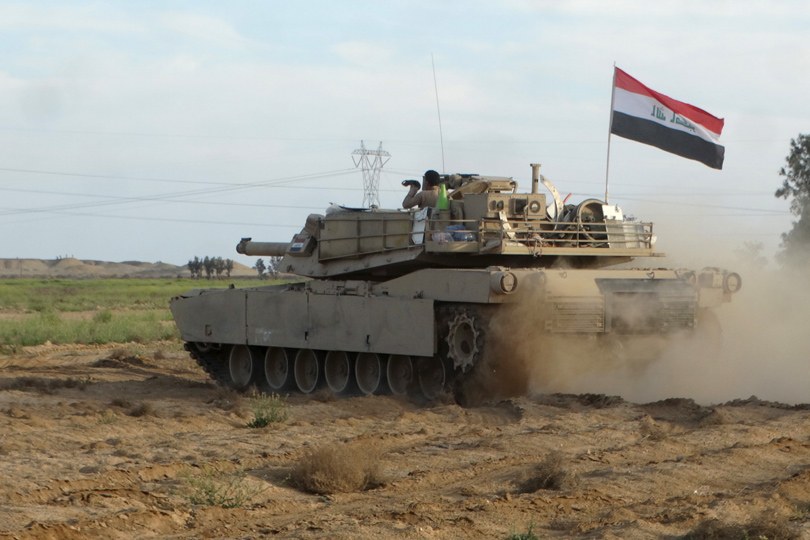MICHAEL KNIGHTS
The Iraq-Syria border has emerged in recent months as the hottest piece of real estate in the multi-sided struggle between the Islamic State (ISIS), anti-ISIS fighters, and Iran’s militia proxies. Why is this? I’ve stood on the Iraq-Syrian border many times and it is not much to look at. Empty desert stretches as far as the eye can see along almost all of its 600km length. The border is rarely marked by anything more substantive than an earth berm, which is frequently cut with gaps made by smugglers and terrorists.
To understand the value of the border to the various armed actors, one has to get into the minds of people from the region and see the symbolism of a piece of land that connects Iran to the Mediterranean. In practical terms, such a route could give Iran land access to Lebanese Hezbollah and the Assad regime, which would be very useful in the event that Iran’s allies cannot use airports in Lebanon and Syria during a future war. This is why Iran-backed militia forces on both the Syrian and Iraqi sides of the border have struck out into empty, and largely undefended, desert to mount symbolic “flag-planting” exercises along the border.
When U.S. forces twice bombed Iran-backed militias in Syria for getting too close to a U.S. base at Tanf – just inside Syria at the Iraq-Syria-Jordan triborder – the militias simply gave the base a wider berth and planted their flag on the border further to the east. On the Iraq side of the border, Iran-backed elements of the Iraqi state’s Popular Mobilization Forces (PMF) and the Federal Police have established a presence deep in the Sunni-populated Western Desert of Iraq. They appear intent on formalizing this presence and reaching arrangements with local Sunni tribes to gain their tacit consent to stay. If PMF and Federal Police outreach to Sunni tribes is unsuccessful or heavy-handed, there could be a new opening for ISIS to recruit local Sunni insurgents to resist the outsiders.
At the other end of the border – about 80km south of the Turkey-Iraq-Syria triborder – Iran-backed elements of the PMF reached the border at the end of May and are developing a network of long-term bases at Tall Afar airbase and Ba’aj. To reach the border in this area, the PMF have waded into a byzantine alphabet soup of three-letter local militias backed by the Turkish-backed Iraqi Kurds, the anti-Turkish Kurdistan Worker’s Party (PKK), the Syrian Kurds, Baghdad, and local Yezidi groups. The result is a patchwork quilt of security forces tensely operating in close proximity. Though these forces are presently just observing each other, there is a good chance that this is merely the calm before the storm. For instance, Turkey and the Iraqi Kurds may launch an offensive to exclude the Syrian Kurdish People's Defense Units (YPG) and the PKK from the Sinjar area of the Iraq-Syria border. The trigger is likely to be the YPG-led liberation of Raqqa, whereupon the U.S.-led coalition might become less dependent on the PKK-affiliated Syrian Kurds and less inclined to restrain Turkey.
Lastly, there is the central portion of the Iraq-Syrian border, which is still up for grabs. Currently the PMF are just a 180km desert trek north of Al-Qaim district, an ISIS-controlled area where the Euphrates River crosses the border in the direction of key ISIS strongholds like Deir ez-Zoir and Raqqa. Federal Iraqi government forces backed by the U.S.-led coalition are a 150km highway drive southeast of Al-Qaim. Though Iran-backed and Iraqi forces could race for Al-Qaim, they are more likely to pursue a collaborative approach, because the area is a hard target – a 20km-long string of towns that are heavily defended and connected directly to ISIS’ remaining areas of strength in Syria. No one is planting a flag on the border in Al-Qaim without weeks of heavy fighting beforehand.
The battle for the Iraq-Syrian border operates on two levels – the symbolic and the practical. At the symbolic level, Iran and her proxies are achieving great success in planting their flags along the border. Their rationale – to interdict ISIS ability to use the border – conceals their real purpose, which is to reclaim the mantle of the most important forces fighting ISIS and to gain advantages in the future use of the border. For real control of the border, Iran’s proxies will need to establish permanent bases and logistical arrangements to sustain their forces, on both sides of the border, astride the key trade routes. This will not be an easy task in the face of competition from the Iraqi government, Syrian Sunni oppositionists, and the Syrian Kurds. This suggests that the battle for the border will be a long, draw-out game of geopolitical chess.








Comments